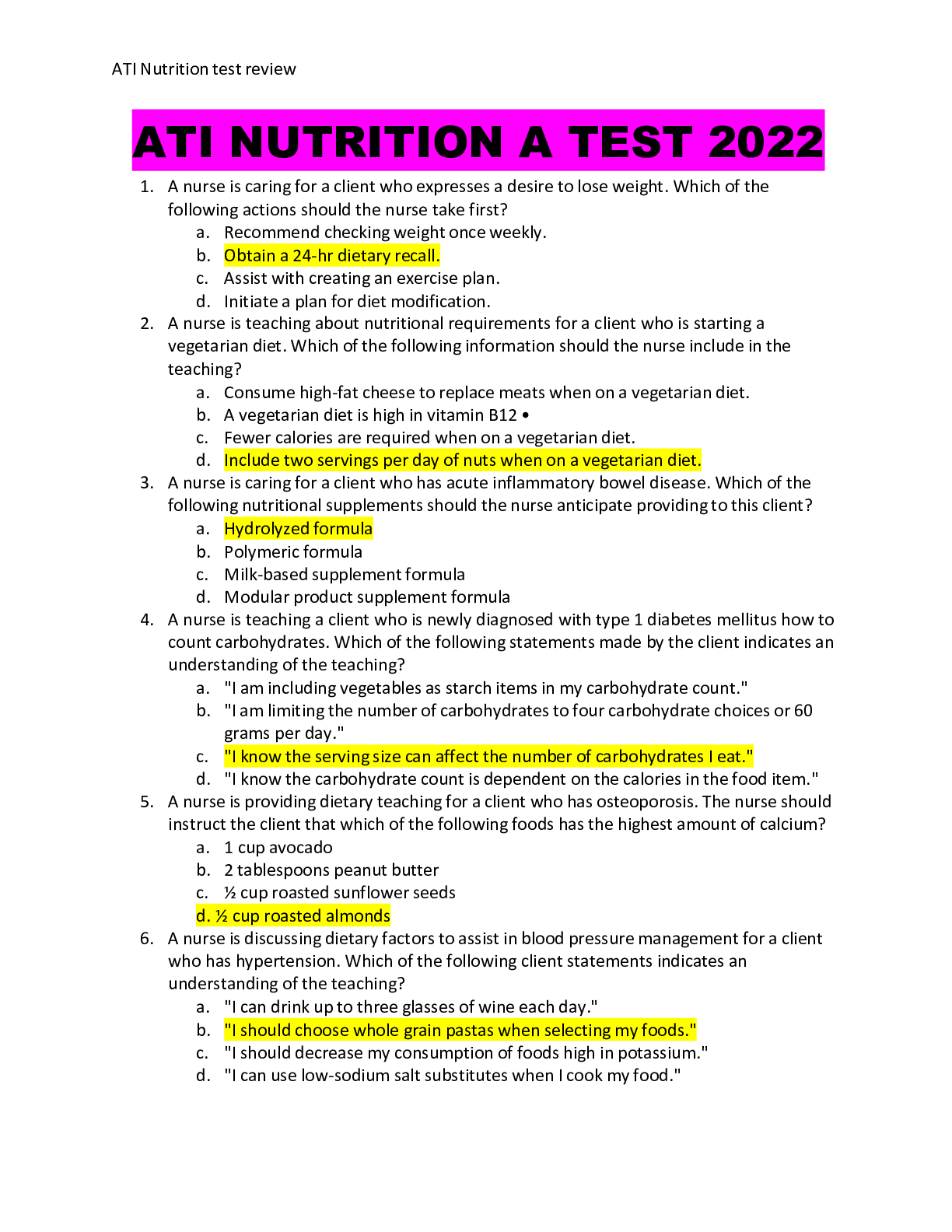*NURSING > QUESTIONS & ANSWERS > NUR242 Questions and Answers Already Rated A+ (All)
NUR242 Questions and Answers Already Rated A+
Document Content and Description Below
Question 1: (see full question) To assess the frequency of a woman's labor contractions, the nurse would time: You selected: the beginning of one contraction to the beginning of the next. Correct... Explanation: Measuring from the beginning of one contraction to the next marks the time between contractions. Reference: Ricci SS (2017). Essentials of Maternity, Newborn, and Women’s Health Nursing. 4th ed. Philadelphia: Wolters Kluwer, Chapter 14: Nursing Management During Labor and Birth: p. 453. Question 2: (see full question) A woman states that she does not want any medication for pain relief during labor. Her primary care provider has approved this for her. What the nurse's best response to her concerning this choice? Correct response: “I respect your preference whether it is to have medication or not.” Explanation: Individualizing care to meet women's specific needs is a nursing responsibility. Reference: Ricci SS (2017). Essentials of Maternity, Newborn, and Women’s Health Nursing. 4th ed. Philadelphia: Wolters Kluwer, Chapter 14: Nursing Management During Labor and Birth: p. 464. Question 3: (see full question) The pain of labor is influenced by many factors. What is one of these factors? Correct response: The woman is prepared for labor and birth. Explanation: The woman who enters labor with realistic expectations usually copes well and reports a more satisfying labor experience than does a woman who is not as well prepared. Reference: Ricci SS (2017). Essentials of Maternity, Newborn, and Women’s Health Nursing. 4th ed. Philadelphia: Wolters Kluwer, Chapter 14: Nursing Management During Labor and Birth: p. 464. Question 4: (see full question) A client is now in the second stage of labor. While doing the assessment, the nurse would gather what data at this time? Correct response: contraction pattern every 15 minutes Explanation: Assess the contraction pattern every 15 minutes. The pattern will be similar to that found in the transition phase (i.e., contractions occur every two to three minutes, last 60 to 90 seconds, and are of strong intensity). (less) Reference: Ricci SS (2017). Essentials of Maternity, Newborn, and Women’s Health Nursing. 4th ed. Philadelphia: Wolters Kluwer, Chapter 14: Nursing Management During Labor and Birth: p. 487. Question 5: (see full question) When assessing fetal heart rate patterns, which finding would alert the nurse to a possible problem? Correct response: prolonged decelerations Explanation: Prolonged decelerations are associated with prolonged cord compression, abruptio placentae, cord prolapse, supine maternal position, maternal seizures, regional anesthesia, or uterine rupture. Variable decelerations are the most common deceleration pattern found. They are usually transient and correctable. Early decelerations are thought to be the result of fetal head compression. They are not indicative of fetal distress and do not require intervention. Fetal accelerations are transitory increases in FHR and provide evidence of fetal well-being. (less) Reference: Ricci SS (2017). Essentials of Maternity, Newborn, and Women’s Health Nursing. 4th ed. Philadelphia: Wolters Kluwer, Chapter 14: Nursing Management During Labor and Birth: p. 462. Question 1: (see full question) The nurse explains Leopold’s maneuvers to a pregnant client. For which purposes are these maneuvers performed? Select all that apply. Correct response: • determining the presentation of the fetus • determining the position of the fetus • determining the lie of the fetus Explanation: Leopold maneuvers help the nurse to determine the presentation, position, and lie of the fetus. The approximate weight and size of the fetus can be determined with ultrasound sonography or abdominal palpation. (less) Reference: Ricci SS (2017). Essentials of Maternity, Newborn, and Women’s Health Nursing. 4th ed. Philadelphia: Wolters Kluwer, Chapter 14: Nursing Management During Labor and Birth: p. 453. Question 2: (see full question) While waiting for the placenta to deliver during the third stage of labor the nurse must assess the new mother's vital signs every 15 minutes. What sign would indicate impending shock? Correct response: tachycardia and a falling blood pressure Explanation: Monitor the woman's vital signs at least every 15 minutes during the third stage of labor. Tachycardia and a falling blood pressure are signs of impending shock; the nurse should immediately report these signs. (less) Reference: Ricci SS (2017). Essentials of Maternity, Newborn, and Women’s Health Nursing. 4th ed. Philadelphia: Wolters Kluwer, Chapter 14: Nursing Management During Labor and Birth: p. 491. Question 3: (see full question) The nurse caring for a client in preterm labor observes abnormal fetal heart rate (FHR) patterns. Which nursing intervention should the nurse perform next? You selected: administration of oxygen by mask Correct Explanation: The client should be administered oxygen by mask because the abnormal FHR pattern could be due to inadequate oxygen reserves in the fetus. Because the client is in preterm labor, it is not advisable to apply vibroacoustic stimulation, tactile stimulation, or fetal scalp stimulation. (less) Reference: Ricci SS (2017). Essentials of Maternity, Newborn, and Women’s Health Nursing. 4th ed. Philadelphia: Wolters Kluwer, Chapter 14: Nursing Management During Labor and Birth: p. 460. Question 4: (see full question) As a woman enters the second stage of labor, which would the nurse expect to assess? Correct response: feelings of being frightened by the change in contractions Explanation: The nature of contractions changes so drastically to an urge to push that this can be frightening. Reference: Ricci SS (2017). Essentials of Maternity, Newborn, and Women’s Health Nursing. 4th ed. Philadelphia: Wolters Kluwer, Chapter 14: Nursing Management During Labor and Birth: p. 487. Question 5: (see full question) A woman is in the fourth stage of labor. During the first hour of this stage, the nurse would assess the woman's fundus at which frequency? Correct response: every 15 minutes Explanation: During the first hour of the fourth stage of labor, the nurse would assess the woman's fundus every 15 minutes and then every 30 minutes for the next hour. Reference: Ricci SS (2017). Essentials of Maternity, Newborn, and Women’s Health Nursing. 4th ed. Philadelphia: Wolters Kluwer, Chapter 14: Nursing Management During Labor and Birth: p. 491. Question 1: (see full question) What is the normally accepted fetal heart rate range? You selected: 110–160 bpm Correct Explanation: The standard acceptable fetal heart rate baseline is the range of 110–160 beats per minute. Sustained heart rates above or below the norm are cause for concern. (less) Reference: Ricci SS (2017). Essentials of Maternity, Newborn, and Women’s Health Nursing. 4th ed. Philadelphia: Wolters Kluwer, Chapter 14: Nursing Management During Labor and Birth: p. 460. Question 2: (see full question) A nurse is monitoring the FHR of a client in labor using an electronic fetal monitor. The reading shows a late deceleration. Which intervention should the nurse implement? You selected: Change maternal position to an upright or side lying position. Correct Explanation: To intervene with late decelerations, the nurse should change maternal position to an upright or side lying posture. Late deceleration in the fetus indicates insufficient uteroplacental perfusion. Changing the maternal position improves the maternal venous return. In upright position, the uterine activity becomes more efficient. Attempts should be made to increase the uteroplacental perfusion and fetal circulation. Administering oxytocin and encouraging Valsalva maneuver (extended breath holding) may augment the uteroplacental insufficiency. In late deceleration, the nurse should administer oxygen through nasal cannula and discontinue administration of oxytocin. Placing the client in the lithotomy position contributes to poor placental circulation. (less) Reference: Ricci SS (2017). Essentials of Maternity, Newborn, and Women’s Health Nursing. 4th ed. Philadelphia: Wolters Kluwer, Chapter 14: Nursing Management During Labor and Birth: p. 463. Question 3: (see full question) A woman in early labor is using a variety of techniques to cope with her pain. When the nurse enters the room she notes that the woman is making light, circling movements with her fingertips across her abdomen. What technique is she using? Correct response: effleurage Explanation: Effleurage is a form of touch that involves light circular fingertip movements on the abdomen and is a technique the woman can use in early labor. The theory is that light touch stimulates the nerve pathways to the brain and keeps them busy, thereby blocking the pain sensation. (less) Reference: Ricci SS (2017). Essentials of Maternity, Newborn, and Women’s Health Nursing. 4th ed. Philadelphia: Wolters Kluwer, Chapter 14: Nursing Management During Labor and Birth: p. 470. Question 4: (see full question) A nurse is caring for a client who has been administered an epidural block. Which should the nurse assess next? You selected: respiratory rate Correct Explanation: The nurse must monitor for respiratory depression. Monitoring the client's respiratory rate will be the best indicator of respiratory depression. Reference: Ricci SS (2017). Essentials of Maternity, Newborn, and Women’s Health Nursing. 4th ed. Philadelphia: Wolters Kluwer, Chapter 14: Nursing Management During Labor and Birth: p. 474. Question 5: (see full question) The nurse is reviewing the uterine contraction pattern and identifies the peak intensity, documenting this as which phase of the contraction? Correct response: acme Explanation: The acme is the peak intensity of a contraction. The increment refers to the building up of the contraction. The decrement refers to the letting down of the contraction. Diastole refers to the relaxation phase of a contraction. (less) Reference: Ricci SS (2017). Essentials of Maternity, Newborn, and Women’s Health Nursing. 4th ed. Philadelphia: Wolters Kluwer, Chapter 14: Nursing Management During Labor and Birth: p. 453. Question 1: (see full question) A woman is lightly stroking her abdomen in rhythm with her breathing during contractions. The nurse identifies this technique as: Correct response: effleurage. Explanation: Effleurage is a light, stroking, superficial touch of the abdomen in rhythm with breathing during contractions. Acupressure involves the application of a finger or massage at a trigger point to reduce the pain sensation. Patterned breathing involves controlled breathing techniques to reduce pain through a stimulus–response conditioning. Therapeutic touch involves light or firm touch to the energy field of the body using the hands to redirect the energy fields that lead to pain. (less) [Show More]
Last updated: 1 year ago
Preview 1 out of 71 pages
Instant download
.png)
Buy this document to get the full access instantly
Instant Download Access after purchase
Add to cartInstant download
Reviews( 0 )
Document information
Connected school, study & course
About the document
Uploaded On
Sep 13, 2021
Number of pages
71
Written in
Additional information
This document has been written for:
Uploaded
Sep 13, 2021
Downloads
0
Views
61

.png)
.png)
.png)
.png)
.png)
.png)
.png)
.png)
.png)
.png)
.png)

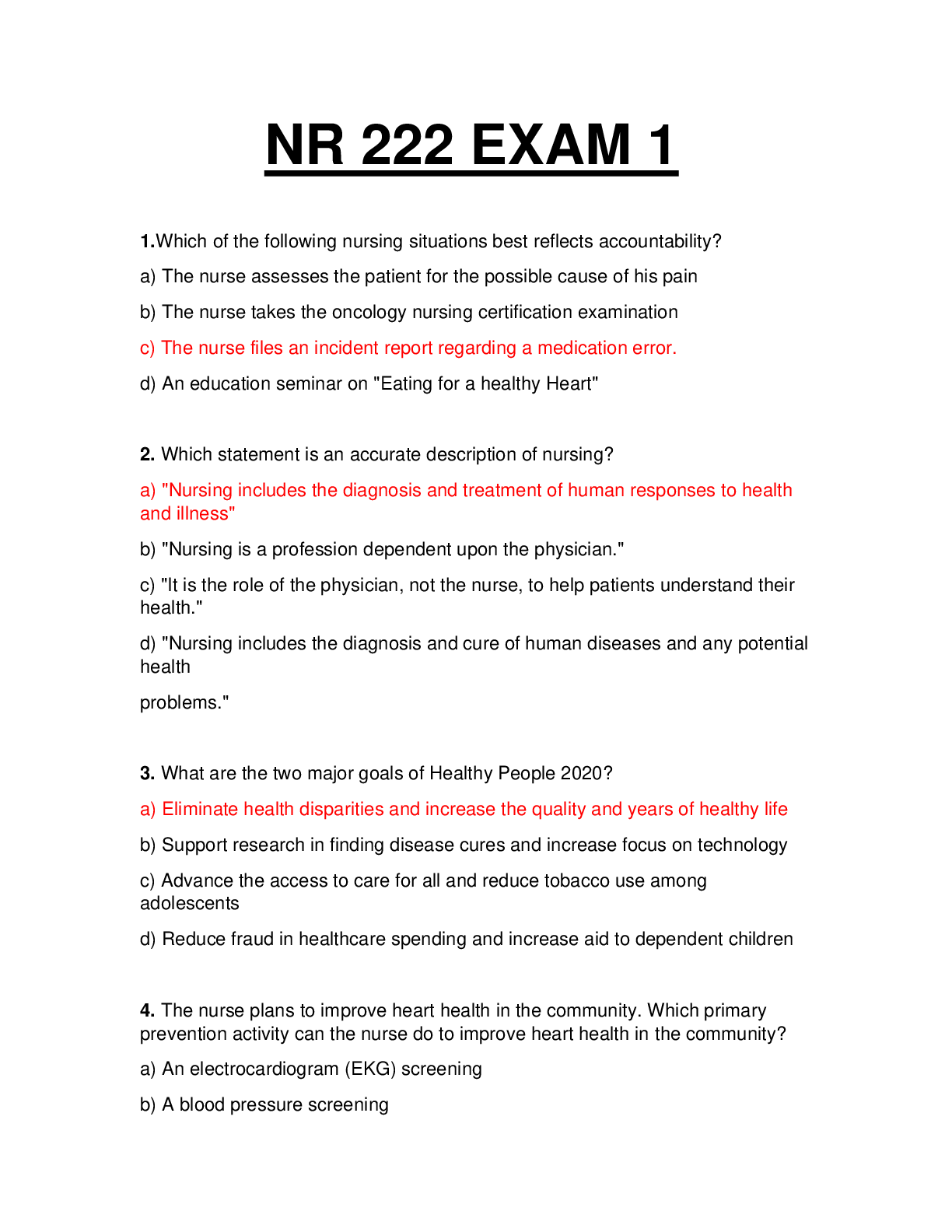



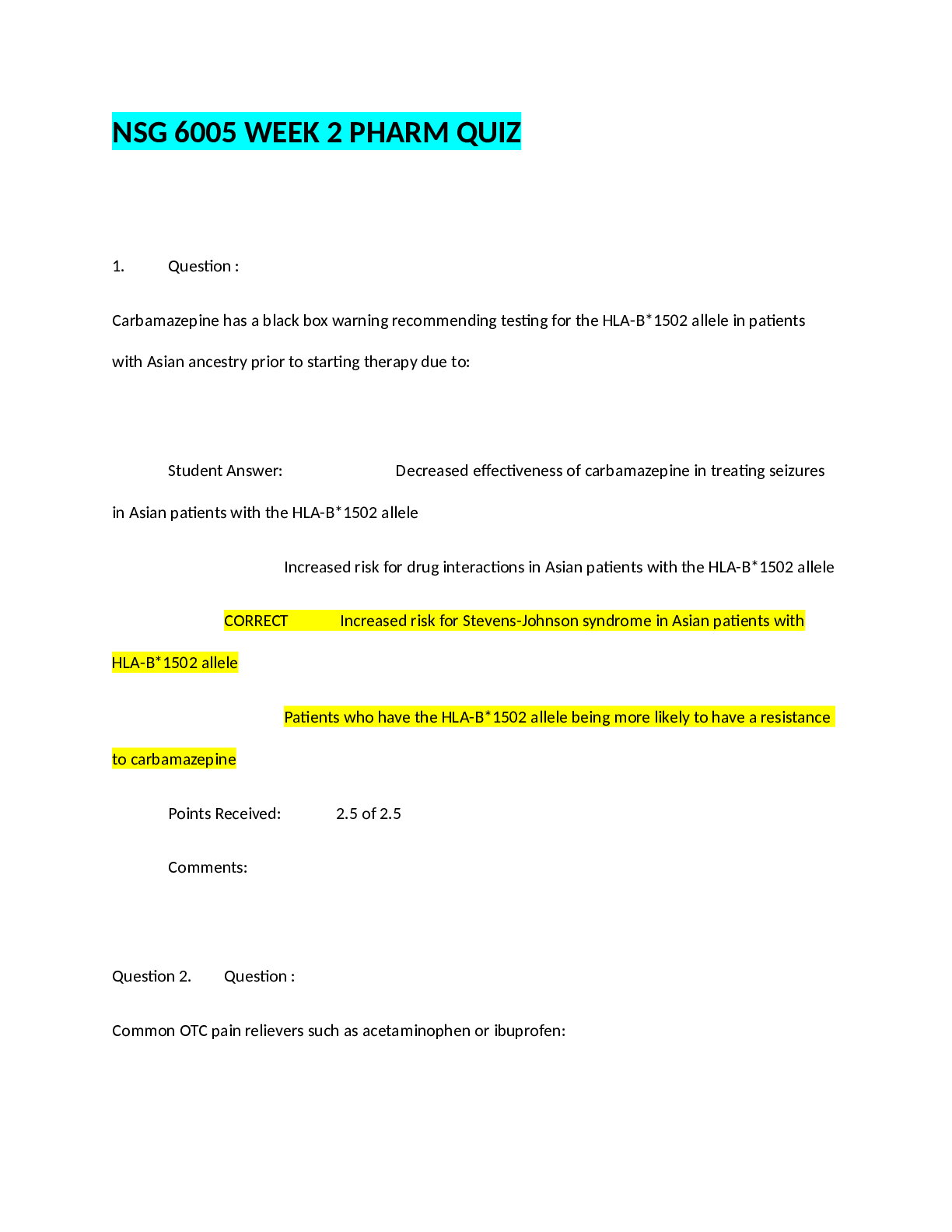



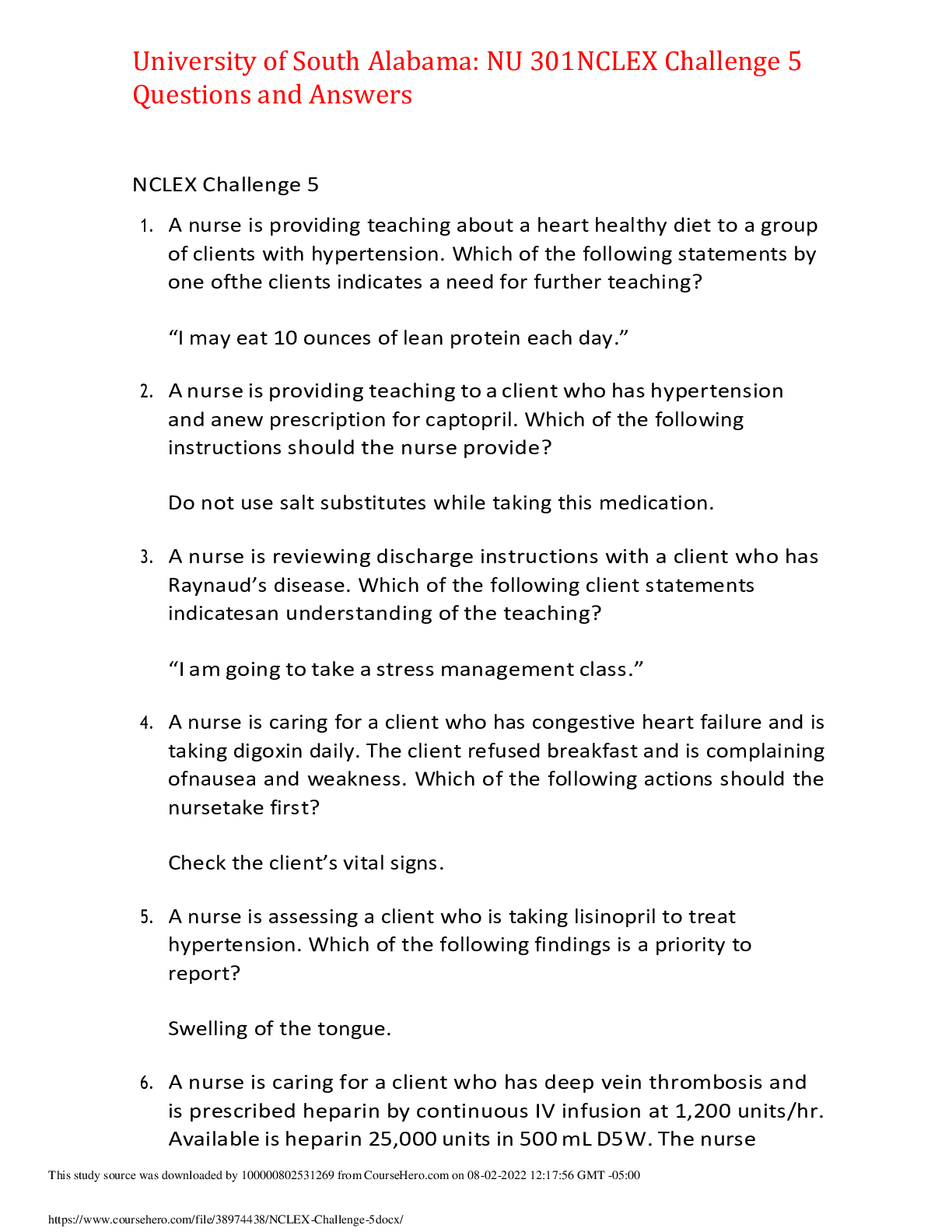
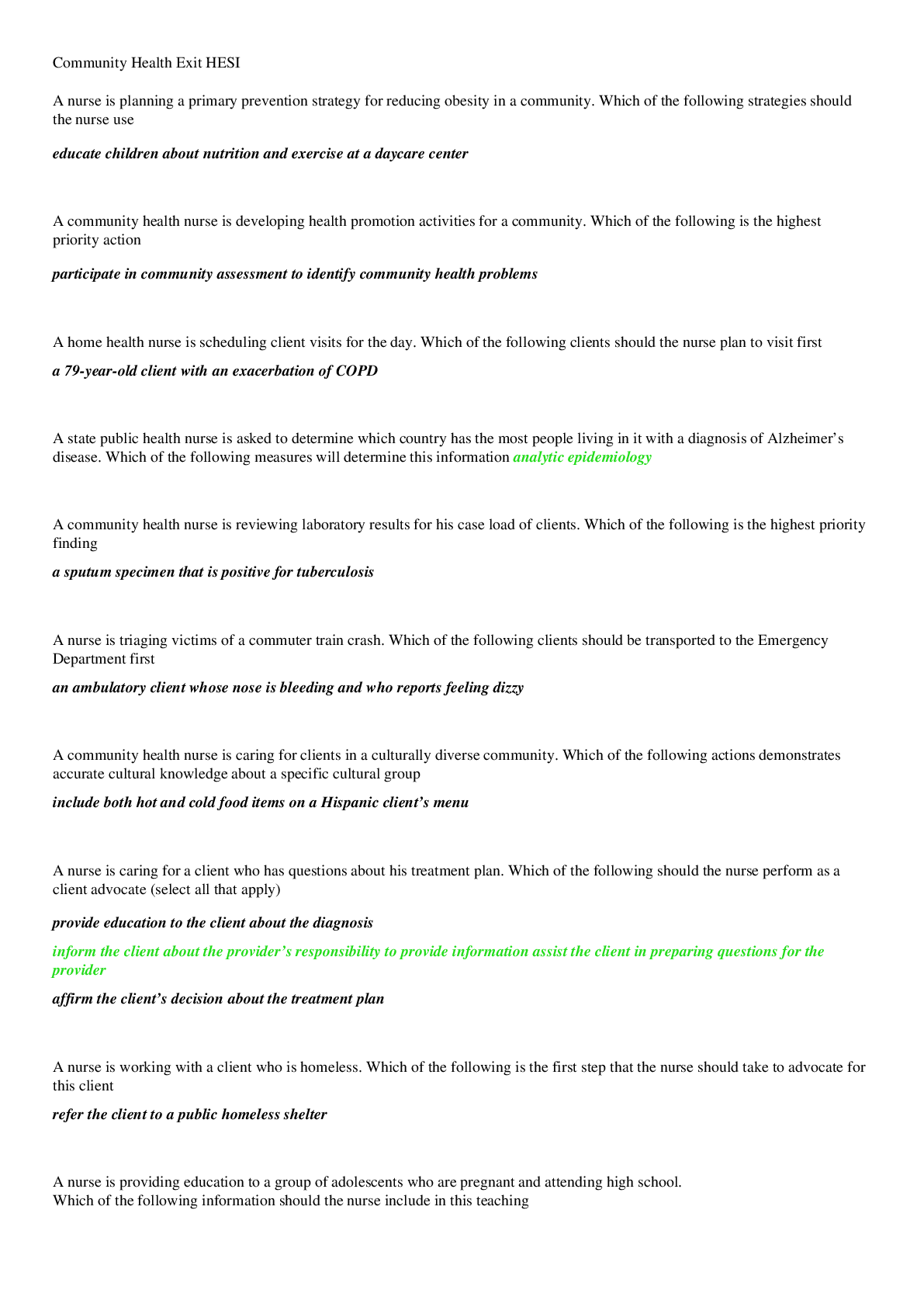
.png)
